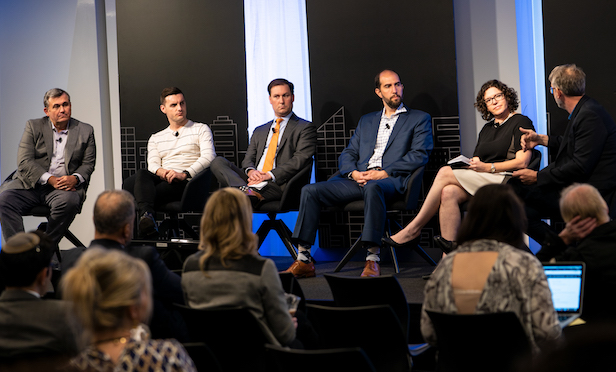
NEW YORK CITY—The amount of information about buildings and their tenants is enormous. Building owners, operators and tenants are still learning how to manage and leverage that data to improve environments to ultimately increase revenue.
WeWork collects data on how members use conference rooms. Looking at booking times, they can predict future behavior. “Designers in the studios have configured a floor plan layout before they go too far down the decision-making path,” said the director of construction technology at WeWork Tim Dumatrait. “That has been really helpful in right-sizing the product before we make hard decisions.” With enterprise clients, they study how employees use the workplace, to increase employee satisfaction and retention.
Dumatrait was one of the panelist in a session “Using Data to Improve Workplace and Development Decisions” at a building innovations event. It was organized by Honest Buildings, a project management platform, and Convene, a flexible workspace, amenities and service provider. The programs took place at Convene's location at 117 W. 46th St. in Midtown Manhattan on Friday.
In contrast to Dumatrait, Kent Tarrach, VP of asset management and global corporate development at Brookfield Properties, primarily works with clients seeking long-term leases. However, driven by the influx of co-working options and anecdotal demands of clients, Brookfield has started to provide similar solutions to stay competitive. Previously their pre-built suites were around 5,000 square feet. Now, Brookfield is seeing greater traction for 10,000 and 15,000 square-foot pre-built spaces.
Brookfield uses data through VTS and CompStak to identify how fast prebuilt space is leasing compared to raw space. They track data to quantify costs in building out space to calculate how quickly they can recoup these amounts.
“We are looking towards larger enterprise tenants to provide them with a large amount of fixed square footage for their core operations but then provide them with a flex office solution, if they are looking to spin off a new business or allow room if they don't know exactly how large that group is going to be, using that space for six months to three years,” said Tarrach. He added companies with overseas operations without an office would also want flexible office spaces. “There are plenty of opportunities for us to co-exist with various co-working options, certainly WeWork being the largest.”
Chris Zlocki, head of innovation at Colliers International, noted it's not only the space that has changed but the work, itself. Thirty years ago 20% of work was done in teams. Now this figure is 80% to 90%, according to Zlocki. Plus, teams come together for six months, then disband. Work no longer means coming to your desk from nine to five. Thus, office real estate is evolving with the times.
In addition, he sees technology moving from providing data to predictive analytics. “With the evolution of blockchain, what's interesting is the amount of information that's going to be free and public, about occupancy, cost and ownership.” He added that with a layer of AI and machine learning, the process will go from Alexa telling you the temperature to telling you to buy property in Singapore or New York because the market has shifted.
“For me, what's so exciting is this is all about to emerge. It's like electricity in this industry. This is going to be transformational,” Zlocki said.
Brookfield is looking into adding sensor systems and networks into their buildings to track how people utilize spaces. They would provide that information to tenants, for adjustments to programs to make building use as efficient and effective as possible.
Sensitive to privacy concerns, Tarrach said Brookfield did not want to become “Big Brother” and would collect what was authorized, explaining the benefits to tenants.
Melissa Marsh, the senior managing director of occupant experience at Savills Studley, said tenants would benefit by gaining more control over their environments and people could design better future conditions with more information. A critical piece would be an opting-in by consumers. The world is going to get better, more functional and more sustainable when the consumer is better educated, she said. As to privacy issues, she noted, “We've learned over time, if you are not paying with cash, you are paying with information. There is a give and take.”
© Touchpoint Markets, All Rights Reserved. Request academic re-use from www.copyright.com. All other uses, submit a request to [email protected]. For more inforrmation visit Asset & Logo Licensing.







